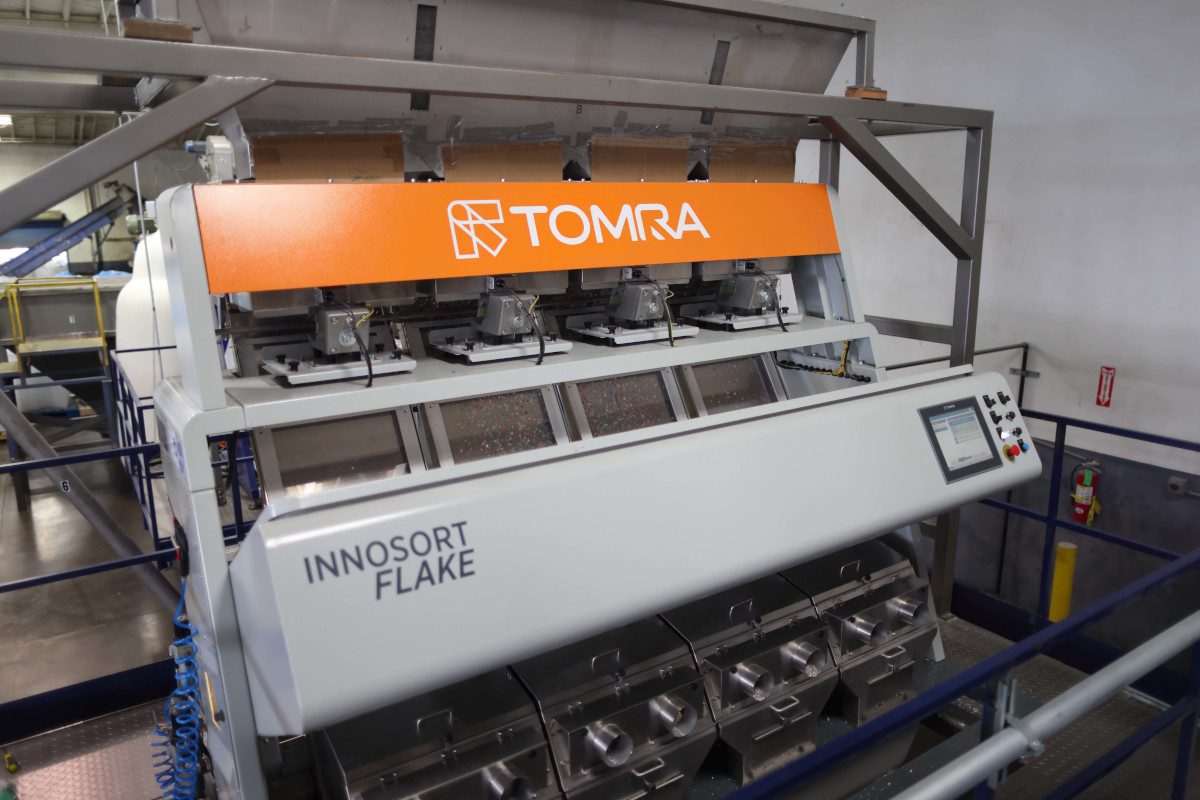
California-based full-service recycler, processor and manufacturer, Greenpath Enterprises, has partnered with TOMRA Recycling Sorting to install and optimise a plastic flake sorting production line designed to identify and separate mixed polyolefin caps from beverage bottles.
Operating for more than 25 years, the vertically integrated Greenpath accepts a wide range of materials, and the infeed stream is somewhat inconsistent. Greenpath creates value being a one-stop solution by accepting mixed infeed loads with variable supply streams and producing consistent, quality products.
In terms of post-consumer polyolefins – low-density polyethylene (LDPE), high-density polyethylene (HDPE) and polypropylene (PP) – Greenpath accepts film, rigid plastics and bottle caps.
“Polypropylene and polyethylene (PE) are together the most abundant plastic family on earth, but the mixed polyolefin market is limited for valuable applications,” comments Eric Olsson, area segment manager, plastics for TOMRA.
PE and PP have very close density characteristics and are challenging to separate. So, mixed polyolefins are primarily downcycled into more forgiving applications that allow for more contamination.

The quest for cap to cap
A more mature PET recycling infrastructure has led to brand owners incorporating up to 100% post-consumer recycled content (PCR) material in their bottles. As regulations tighten to increase the percentage of recycled content, the next logical container component to address is the cap. “We are at the genesis of creating a sorting system for caps that is similar to what is more common today for bottles. Following Greenpath’s approach, the industry can move toward a 100% PCR by weight package using only a mechanical sortation,” says Olsson.
Greenpath has extensive processing capabilities with different lines to sort diverse feedstock and is adept at mechanical, multi-material and batch recycling processes. To close the loop on caps, Greenpath investigated various technologies to sort the mixed polyolefins. With PE and PP densities being very close to one another, float/sink tanks were not deemed effective, and other recycling technologies didn’t offer the desired recovery for both PE and PP resins. “The yields are low, and you have to consider the expenditure, space and waste generated from the separation process,” says Castro.
Greenpath zeroed in on a mechanical solution using flake sorters and met with TOMRA to discuss its new INNOSORT FLAKE™ sorting technology. One of its design parameters was to extract value from multicomponent plastic waste streams.
“Developing a mechanical sorting process to close the loop for food-grade cap-to-cap recycling by consistently separating mixed polyolefins by polymer and colour with high purity is a game changer,” comments Joe Castro, president of Greenpath Enterprises, Colton, California.
“It’s best to pursue a path that introduces the least amount material change and sorts in the most efficient way, and we haven’t begun to reach the ceiling limit for mechanical polyolefin sorting,” comments Olsson. “Producing 95% or greater purity-by-polymer streams is critical for many types of downstream recycling processes, and flake sorting can get us there.”
Mechanical sorting flexibility
Greenpath’s purity, yield and throughput goals led them to selecting INNOSORT FLAKE. The unit does not require a large footprint, allowing for easier integration.
Designed for flexibility, INNOSORT FLAKE incorporates a unique combination of sensor technologies, including colour cameras capable of identifying 16.8 million colour variations. “A camera is positioned on each side of the chute, so it can see the difference between each side of the flake,” explains Olsson. This helps to identify in-mould labelling that can be a contaminant.
Its FLYING BEAM lighting system offers fast and reliable material detection by the sorter’s near-infrared (NIR) sensors. Homogeneous light distribution ensures classification of PE and PP materials, as well as other polymers and materials. Integrated into the scanner box for protection against damage, it offers up to 80% energy savings over conventional light sensors.
Configuration flexibility allows for single- or multi-step sorting with the same unit. “We can split the machine into multiple sorting tasks by chute and even split a chute into two different process streams or more,” says Olsson. Castro adds, “TOMRA’s technology allows us to purify at a higher level that opens up the whole circular opportunity with going cap to cap,” he says.
Optimising for consistency
Both companies have been committed to getting the process right and have paid special attention to sorting optimisation. “We wanted a company who would support us on this journey. TOMRA has been very supportive in this project. It has been more like a partnership,” says Castro.
Optimising the process means meeting Greenpath’s high purity goals of mono-polymer PE and PP from inconsistent mixed polyolefin feedstock. While there is still some work to be done at the facility, “mechanical viability is there,” confirms Olsson.
The system first sorts by polymer using INNOSORT FLAKE and then by colour. “If a customer wants a natural or specific sorted colour PE or PP product, we can purify and provide them a sorted colour that meets their specific application using PCR,” says Castro.
TOMRA’s Olsson shows optimism for the accomplishment, its impact on the market and what it means for packaging companies trying to meet recycled content targets. “We’re at the beginning for mixed waste streams of polyolefins going closed loop. It won’t just be a pipe dream for polyolefins anymore.”







